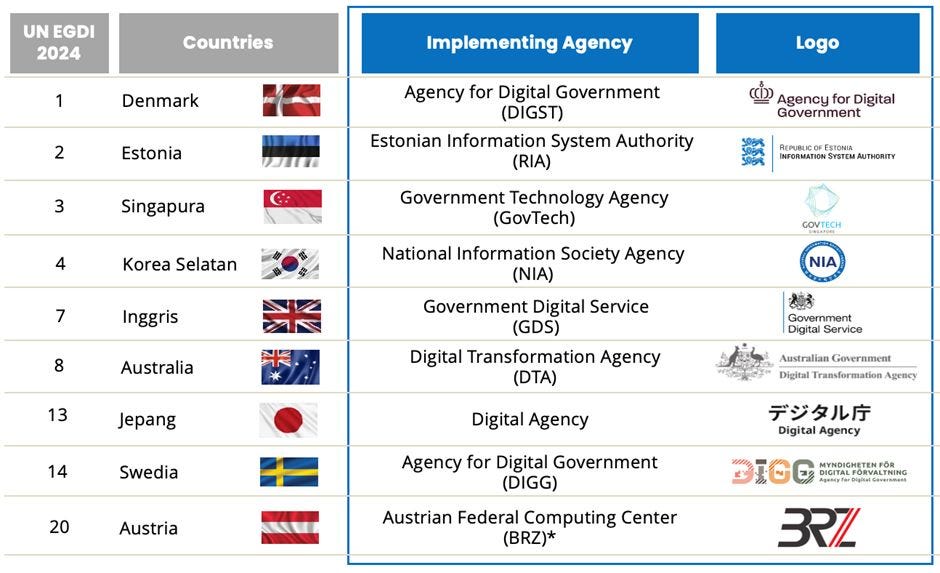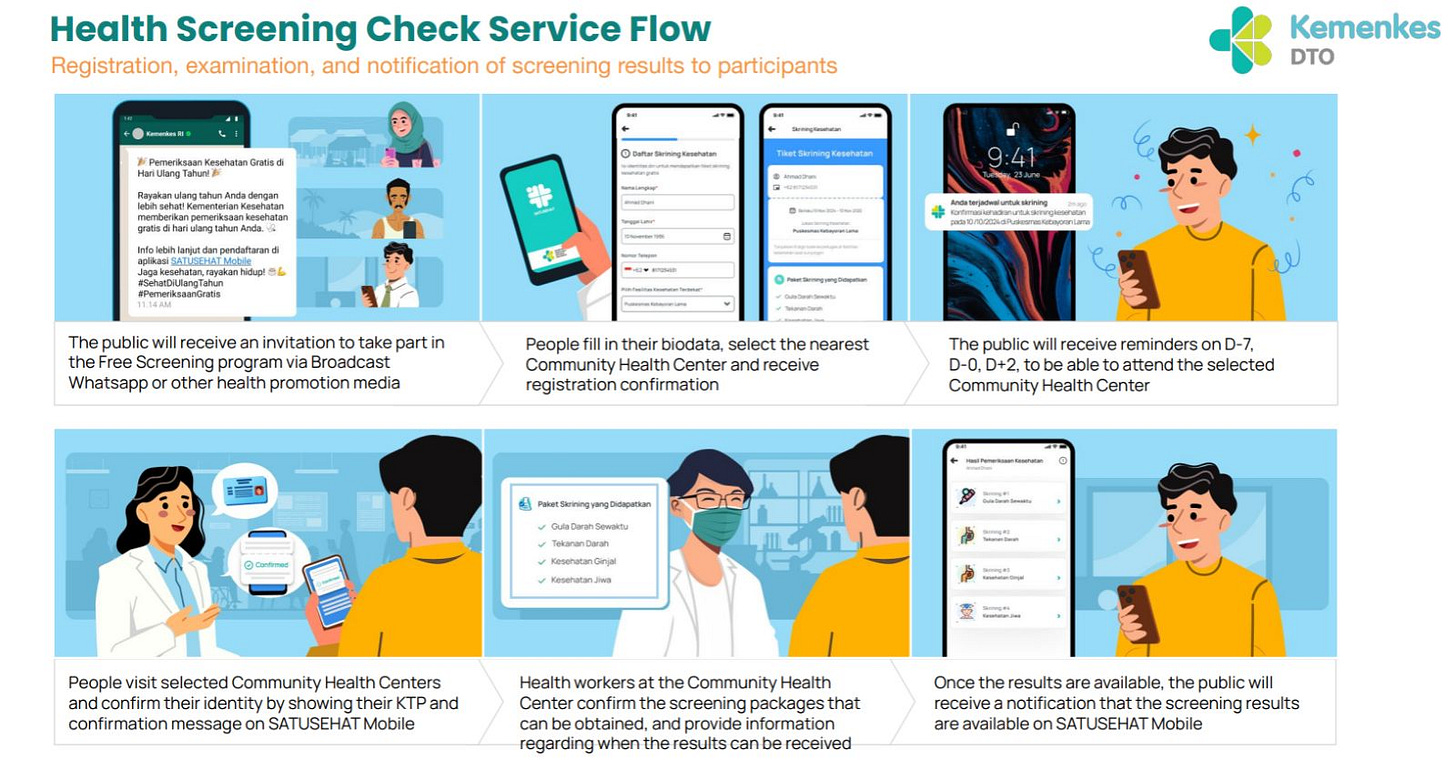How Indonesia’s digital reforms aim to bring increased cohesion to its GovTech landscape
Edition #120 (GovMesh Digest) Pandu Putra and Setiaji share how the Indonesian government is working to provide a holistic digital experience for the country’s 280 million population...
Indonesia’s digital government landscape has historically been a fragmented space.
Until recently, responsibilities for government digitalization were spread across the central government: the Ministry for National Development Planning handled data governance; the Ministry of Communications managed digital infrastructure; the Ministry of Home Affairs looked after implementation in regional government; and the Ministry of Administrative and Bureaucracy Reform was developing policy as well as coordinating overall reform.
This often led to challenges in implementation and accountability.
Last year, the previous President Joko Widodo highlighted the possibility of bringing together 27,000 distinct applications and online platforms across the government.
Many of the world’s leading digital governments have adopted the model of a Central Digital Agency. Source: United Nations
“From this year, stop creating new applications, stop creating new platforms. Stop it!”, he said at the time.
In light of this, Indonesian Special Advisor on Digital Transformation to the Minister of Administrative and Bureaucracy Reform (PANRB) Pandu Putra started his GovMesh presentation with a reflection on a pattern seen among many of the leading countries on the UN’s e-Governance index (EGDI).
From Denmark to South Korea, Sweden to Australia to the UK, most of the world’s most advanced digital government nations have a central digital government implementation agency.
Indeed, GovMesh participants had already heard earlier in the day about the successes of the Japanese government in launching and scaling their own Digital Agency.
With this in mind, the Indonesian government launched its own agency back in 2024 to reduce the complexity of its digital bureaucracy.
INA Digital, as the body became known, is today a national implementing unit responsible for in-house development of strategic and priority systems.
Putra didn’t shy away from telling the full story. The first year of INA Digital wasn’t all sunshine, but it has already started to provide important learnings from a “pilot” to produce an alpha version of integrated digital government systems (an internal government portal; integrated Digital ID; and citizen portal).
These lessons have included the need for top-down design, improved institutional coordination, and learnings around funding consolidation and streamlined procurement.
Focusing on the priorities: a broader shift in the digital government landscape
In many ways then, Indonesia is well positioned to continue its digital transformation efforts that are more than 20 years old.
Indeed, digital government continues to be a priority in the country. President Prabowo Subianto twice referred to its importance last August in his State of the Nation address, discussing its crucial role in “reducing corruption significantly” and “ensuring that subsidies reach every family in need”.
To achieve these wins, the incumbent government adopted a three-step process to build on the digital government offerings of the previous administration.
First, there’s an even bigger focus on priority systems and applications, from foundational platforms such as Digital Public Infrastructure to impactful use cases such as poverty alleviation.
This represents a mindset shift from scattered resource allocation to a focus on systems with larger leverage.
Alongside this is the continuous strengthening of institutional governance, both on the policy coordinating committee and the improvement of INA Digital itself.
The hope is that with aligned policy, product direction, and standardized technical quality, it will enable greater systematic integration and interoperability.
Finally, there is also a push for digital funding and procurement reform. This is on top of efforts for a consolidated budget to fund a mandated “Strategic National Project” (PSN) of integrated government digital services in the next 5 years.
These are key moves to enable continuous, flexible, and sustainable “product-based” funding versus current rigid and one-off “project based” mechanisms.
Digital streamlining in a healthcare context
In the second part of Indonesia’s presentation at GovMesh, the Ministry of Health’s Senior Advisor on Technology Setiaji discussed the ramifications of this reformed and centralized approach at an individual ministry level.
Setting the context for the country’s digital healthcare offerings, he reminded participants of Indonesia’s geography and demographics, with over 60,000 health facilities serving a population living across an archipelago of 17,000 islands.
Health screening check service flow. Source: Indonesia’s GovMesh Presentation
It is easy to see how challenges such as fragmentation arise.
The Ministry of Health’s response to these challenges has been to pursue the same focus of improving priority digital apps by streamlining what is already out there.
In this instance, it’s a Covid-19 app. Originally set up to manage citizens’ Covid-19 vaccination certificates and as a test-and-trace mechanism, today it serves as a central hub for storing medical records.
Having citizens’ medical information in one app – with connections to Apple Health and soon Google Health – lays the foundation for a “moments of life” approach by enabling greater interoperability. The app itself is both citizen and healthcare-practitioner facing, as seen in the below Health Screening functionalities.
Health screening service flow for community health center officers. Image: Indonesia’s GovMesh presentation
A couple of years ago, moderating a panel on government superapps, I noted the stark shift from a digital government world where the UK’s Government Digital Service (GDS) famously declared they were “not ‘appy at all” in 2014 on the grounds that they were “very expensive to produce, and very expensive to maintain” to one where leading governments were coalescing around the idea of superapps.
Then, as now, leaders pointed to this being simply a reflection of shifting citizen expectations.
As we discussed in the 2023 panel, most of us start our day scrolling X or watching YouTube, and therefore apps like the health app in Indonesia can reduce our cognitive load.
Indonesia’s digital path forward
As he neared the end of his presentation, Putra expressed optimism about Indonesia’s ability to deliver on these increased expectations.
He talked about this year being a period of “bonus momentum” in Indonesia’s digital government driven by three factors: a new government, new regulations, and the emergence of successful digitalization initiatives that might provide a foundation to build upon.
A new government brings with it new medium and long-term planning, and it comes at the right time, with the old presidential regulations on digitalization expiring in 2024/2025.
Key planned reforms in the new regulations will include the government strategies of focusing on priority systems, improved institutional governance, as well as digital funding and procurement streamlining.
This will look to advance the early momentum from INA Digital’s early pilot products or established digital services like e-Katalog, the Indonesian procurement system.
Getting this right will be crucial.
Putra talked about the new government’s priority use cases such as citizen services (through a “moments of life” approach), poverty alleviation through a better social assistance system, public spending through procurement reform, state revenue through tax services, and business services through an integrated business permit.
Each of these priorities on their own – scaled up to a population of 280 million – could be game-changing for Indonesia.
To get there, there is clearly work to be done, as Putra himself admitted.
There are still challenges in removing the need for physical ID documents, introducing automatic filing via consent-based data sharing, and integrating existing offerings into a minimum number of systems.
Aligning all the stakeholders in the process will also not be easy, but with a laser-sharp focus, bold reforms, and INA Digital, the central government has built a foundation for a modern and integrated digital government ecosystem – even in a country of 17,000 islands.






